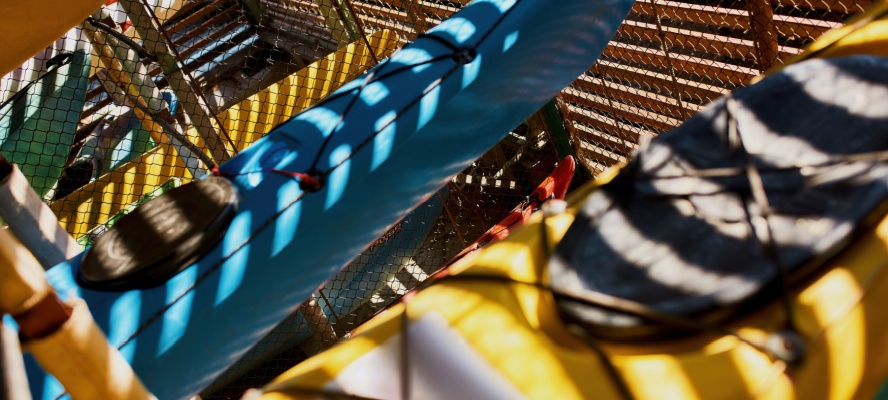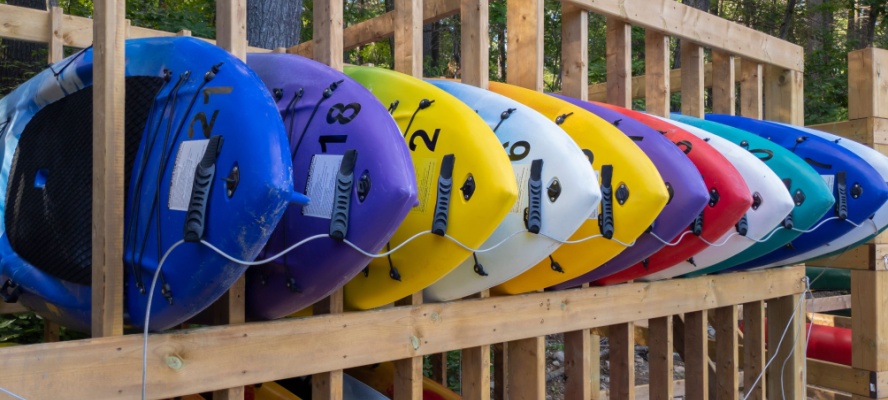Share this article:
For kayak, paddleboard or canoe enthusiasts, few things compare to enjoying the calmness of being out on the water as you take in the sights. But when it’s time to temporarily lay aside your watercrafts for winter, you should know what kind of care they require to make sure you can use them for many years to come.
To help navigate the process of putting away your kayak, paddleboard or canoe for the off-season, we’ve put together this guide looking at how to prepare them for storage, where to store them and storage ideas.
How to prepare your kayak, paddleboard and canoe for storage
To store your kayak, paddleboard or canoe for the off-season, you should make sure you prepare by going through the following steps:
- Clean your watercraft
Any boat should be cleaned first as you get it ready for storage. Use a mild soap to wash away saltwater, sand and mud. Salt can be corrosive, and leftover mud can also become a breeding ground for mold in your kayak, paddleboard, or canoe. Also, it’s good practice to perform this cleaning even before short-term storage. You should also check the manufacturer’s instructions before applying any cleaning agent.
- Let your gear dry completely
Allow your kayak, paddleboard or canoe to thoroughly dry outside for a quarter of an hour before patting them dry with a towel. This is an important step in preventing mold growth on your boat. If you’re working with an inflatable kayak, make sure to allow the spaces in-between chambers and layers to fully dry for the same reason.

- Fix small imperfections
Once they’re dry, you should check them for any damage. For instance, the hull of a kayak can sustain damage as a result of bumping into rocks or accumulating water debris. It might not look like a serious issue at the time, but it can seriously affect the integrity of the vessel in the future. Contact the professionals to fix the issue so your boat can be in the best possible condition.
Remember to look after your accessories in the same way. Think paddles, seats and special gear. Check for any tears, rips or damage. Wash your gear and let it dry thoroughly before putting it into storage. A good practice would be to put them in the same container close to the kayak or the vessel of choice so that you can keep everything together.
- Protect your boats from the elements
Repeated exposure to the elements – whether you’re out on the water or while they’re in storage – can incur damage to your kayak, paddleboard or canoe. For instance, sunlight can cause the color to fade and, in time, can even create cracks on the surface. Going with an indoor option of storage is probably the best way to prevent this kind of damage, but if that’s not possible, you can add a UV protection spray when you’re taking your boat on the water and wax it before long-term storage. Always check with the manufacturer for the best possible treatment. Moreover, for further outdoor use, use a cover slip for each of your boats.
Where to store your kayak, paddleboard and canoe
When it comes to storing your watercraft, the key is to protect them from the elements and ensure they remain in good condition for your next adventure. Ideally, store them in a dry, cool, and well-ventilated space. A garage, shed or dedicated storage area is a great choice. We’ve listed below a few things to consider depending on where you choose to store your kayak, paddleboard and canoe.
Keep your kayak, paddleboard and canoe at home
The first storage option you can consider is your own home. If your apartment or single family home is spacious enough, you can probably keep it at home.
Outdoor storage
Keeping your kayak or paddleboard in the backyard is also possible, but turn to it only if you can’t keep them inside. Go for a shaded area and always use a tarp or a slipcover to keep them from being directly exposed to the wind, sunlight and other weather conditions. Position the slipcover so that rain and snow can’t accumulate on top as the weight of them can deform the shape of your kayak or canoe. Additionally, suspend the cover above the hull rather than wrapping it around the boat. That’s because tight direct contact can become a breeding ground for mold and fungi. As another precaution, don’t let your boat sit directly on the ground. Instead, stand it on its nose or on its side by a wall.
Indoor storage
Storing kayaks, paddleboards or canoes outside is one way to keep it close by, but a garage or a shed is probably a safer alternative during the off-season, which in many places, can coincide with wintertime. This storage solution allows you to protect them from sunlight, snow, sleet, wind and dust, which can wreak havoc on the integrity of your boat in time. A good rule of thumb is to keep them away from windows – to reduce sunlight exposure – and to consider covering them with a tarp to keep the dust away. It would be ideal to keep a steady temperature in the storage area of your choice so as to ensure you’re extending the lifespan of the vessels.

Consider the local marina
If you live in a city with nearby waterways, you can store your kayak or canoe at the local marina or kayak club. Amenities can vary, as some places offer a storage rack, parking, security, and other features. Protect your watercraft with a security lock and insurance — check whether they offer these amenities or if you need to take care of them yourself.
Turn to self storage
If you live in an apartment or your rental single family home doesn’t come with enough space to allow you to safely store your kayak or other smaller vessel at your place of residence, you can turn to self storage to help you keep them over the winter. While inflatable kayaks can be tucked away under the bed or in a closet, the hardshell ones, as well as canoes or paddleboards, can’t be put away so easily, especially if you live in a small apartment. That’s why a climate-controlled unit can be an ideal spot to keep your kayak, paddleboard or canoe undamaged and safe. It provides the right temperature and humidity levels to help the materials keep their properties while you keep a breezy and uncluttered home.
You could probably use a 10’x10’ or 10’x15’ unit to accommodate a kayak or canoe, but if you’re not sure which unit size is best suited for your needs, this storage unit size guide can help you find the best option.
Rates can differ based on location, amenities and other factors. For instance, renting a storage unit in New York City costs $303/month, whereas a San Francisco unit can rent for $347/month. Monthly rates for self storage in Austin, TX ($151/month), Columbus, OH ($120/month), or Raleigh, NC ($119/month), can offer more competitive rates. Here’s how other big cities fare in terms of self storage prices:
How to store a kayak, paddleboard and canoe
Once you’ve found the ideal place to keep your boat(s), it’s time to see which storage solutions you can consider. Kayaks, paddleboards and canoes can easily be stored with a few practical solutions such as:
- Racks
Storage racks can be a great way to store heavier boats, such as a hardshell kayak or a canoe both indoors and outdoors. You can consider a free-standing rack, a wall-attached one or a ceiling rack. These are practical storage solutions for your home or your storage unit. Racks can have multiple storage capabilities – for instance, they can keep your kayak or paddleboard in the same place.
Freestanding racks come in different sizes and can accommodate more than two kayaks. This can be an excellent storage idea for a storage unit where you have more floor space. You can DIY your racks using PVC and plumbing pipes if you enjoy carpentry. This storage solution is ideal for paddleboards as these can sit propped on the ground. Place the paddleboard against the wall, securing it with a strap and add a base for support. Go for this storage solution if the board is in an area where it can be bumped or knocked to avoid any damage.
Ceiling racks are ideal for paddleboards, kayaks and canoes, too. They can keep your SUP (stand-up paddleboard) unscratched as opposed to keeping it on the ground where it can get damaged. Use a ladder and have another person help you mount it up.

- Suspension systems
A suspension system is basically a storage solution that allows you to suspend your kayak against the wall using ropes. Some of them can hold impressive weights, such as two heavier kayaks. Make sure to hang your watercraft with the hull facing the ceiling for optimal protection. Avoid hanging the boat by the loop, as it can bend it in time.
- Hoists
Similar to wall suspension systems, hoists allow you to go vertical with your storage space. They’re usually used in a garage to hang a watercraft from the ceiling. Use straps around the hull of your kayak or canoe and pull them up. Factor in the height of your garage and the clearance you need to be able to fit your car below.
- Sawhorse
For the DIYers, the sawhorse can be an ideal storage idea. You need construction sawhorses, a bow and a solid support, which you can put together using household items. However, you can also buy folding sawhorse racks, which you can use to store canoes and kayaks on the ground. Place them upside down, which avoids putting too much pressure on the gunwales.
Whether you’re the proud owner of a kayak, paddleboard or canoe, you’re likely to enjoy countless hours of fun on the water in your lifetime. Properly caring for your watercrafts while you’re not using them helps them get ready for the next season and prolongs their lifespan.
Share this article:
Mirela is a real estate writer and lifestyle editor for Yardi. With an academic background in English and translation, Mirela now covers a range of topics including real estate trends, lifestyle and economy. Her previous experience in proofreading academic articles has inspired Mirela to choose a writing career path. In her free time, Mirela enjoys reading, but also hiking and creating art. You can contact Mirela via email.
The Ready Renter has your back
Tips, news, and research curated for renters, straight to your inbox.




Related posts
Subscribe to
The Ready Renter newsletter






